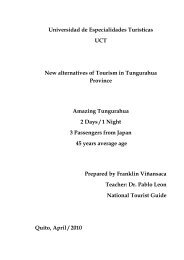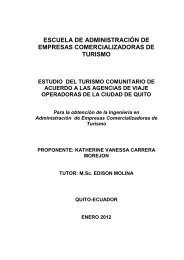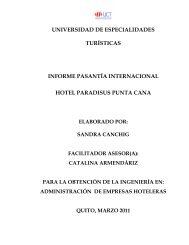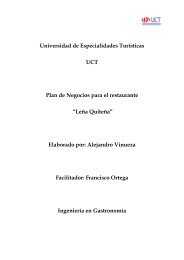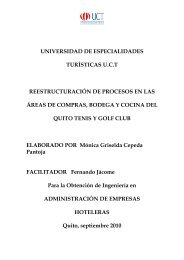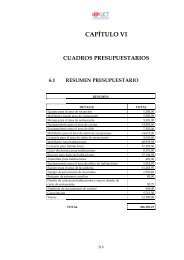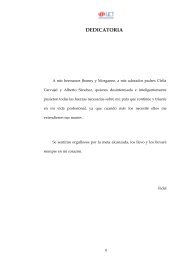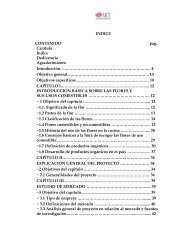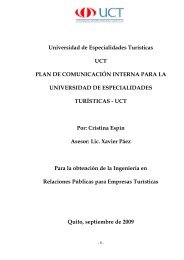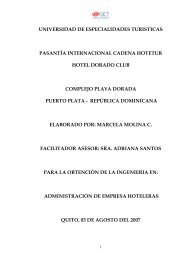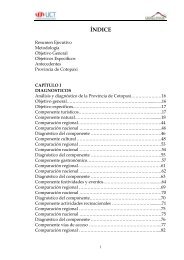Universidad de Especialidades Turísticas UCT Archeologic Carchi ...
Universidad de Especialidades Turísticas UCT Archeologic Carchi ...
Universidad de Especialidades Turísticas UCT Archeologic Carchi ...
You also want an ePaper? Increase the reach of your titles
YUMPU automatically turns print PDFs into web optimized ePapers that Google loves.
<strong>Universidad</strong> <strong>de</strong> Especialida<strong>de</strong>s <strong>Turísticas</strong><br />
Elaborated by:<br />
Diego Arboleda<br />
Tutor:<br />
Enrique Cabanilla<br />
Degree:<br />
National Tourist Gui<strong>de</strong><br />
<strong>UCT</strong><br />
<strong>Archeologic</strong><br />
<strong>Carchi</strong> and Imbabura<br />
2 days one night<br />
3 pax<br />
From France<br />
Archaeologists<br />
Quito, November 2011
Introduction<br />
In Ecuador there is much natural and cultural wealth, talking about the first of<br />
these, it is the most sold and marketed, but it does not mean that the other must<br />
be relegated. The cultural, which is supported by national government, has a<br />
very important framework for work.<br />
Archaeology in the country as a whole, has a very extensive history that is still<br />
being recovered and studied, but very badly that we are losing wealth due<br />
to archaeologicalmisinformation, projects, ambitions and personal interests.<br />
In the North Highland we have visited, there is a very interesting part of the<br />
archaeological study; but, the lack of studies and abandonmentas led to the<br />
hands of the looters are the largest hol<strong>de</strong>rs of thiscultural wealth.<br />
The sites visited were observed as well as unparalleled wealth of art, go and try<br />
to un<strong>de</strong>rstand the reasons for their acts of seeingindigenous cultures but<br />
very interesting places completely neglected and abandoned as Socapamba,<br />
Huataviro, the board among other tolas, the Otavaleño Institution museum of<br />
Anthropology and the Ecuadorian House of Culture of <strong>Carchi</strong>, is a<br />
very necessary and immediate action to recover these assetsand giving the<br />
importance that they should have.<br />
2
TOURIST PROFILE<br />
According to a study on French tourism trends both: sen<strong>de</strong>r and receiver to<br />
be handled within the tourism sector, can be given to know the main<br />
characteristics associated with the archeology of<br />
Ecuador Region, especially North Highland with the routes that<br />
are projected in the following <strong>de</strong>tailed justification as French tourists Itinerary:<br />
Use of Travel Gui<strong>de</strong>s regardless of an operating agency, making short<br />
trips and several activities.<br />
Specialization is accompanied by other activities, not only to the<br />
motivation of the trip.<br />
Latin American passion as visits and contact with communities,<br />
sharing the typical food of the place.<br />
Motivations of natural places, heritage, or direct contact with the field if<br />
required site visits.<br />
Not only to do an activity, archeology as the main topic without<br />
leaving the subject, we talked about what each place has as we passed by<br />
each feature and matched this to archeology.<br />
3
Development<br />
METHODOLOGY<br />
Below, are all the proposed routes and final trip as Real Guidance, and agreed<br />
with everything mentioned below is quoted on the field visits and research<br />
to make the final itinerary with everything that happened during field trips.<br />
These are some drawbacks about the trip and planning of the places was slated<br />
to produce the final product:<br />
We traveled to Milagro town over the bridge a few kilometers near the<br />
way Salinas to San Lorenzo, on the road there is a steep climb on a 30minute<br />
third-or<strong>de</strong>r path through towns like Conception, Incarnation and<br />
Milagro where the road is in a very poor condition and did not allow<br />
us access due to the continuous landsli<strong>de</strong>s in the area from the road<br />
to San Lorenzo.<br />
Site Museums Acknowledgements David Paltán with parts in<br />
disarray and a museum that has no visits; in the future, in San Gabriel,<br />
they will reform it.<br />
Archaeological Museums of El Angel and Huaca have interesting<br />
pieces which are particular people hands, who with<br />
their benevolence and have allowed access.<br />
Pimampiro has a very interesting range of archeology, but at very far<br />
distances, with a trip of 2 days; with the visit to <strong>Carchi</strong> there was no<br />
time to do it.<br />
Museums in Otavalo, Fuller and Victor Vasquez Alejandro Jaramillo are<br />
in current litigation with their relatives, and they are in the hands of the<br />
municipality that does not give the space to display them.<br />
4
Saturday<br />
ITINERARY 1<br />
8:00 Departure from Quito<br />
9:30 Arrival in Guachala and visit to Mama Rosa Cholango House<br />
9:45 Departure from Otavalo<br />
10:00-10:05 Arrival at Miralago<br />
10:05-10:30 Visit to Plaza <strong>de</strong> Ponchos.<br />
11:00-11:30 Visit to IOA<br />
11:30 Departure to Cotacachi<br />
12:00-13:00 Lunch in Cotacachi<br />
13:00-13:20 Departure and arrival in San Antonio <strong>de</strong> Ibarra<br />
13:20-13:40 Visit to Tolas Huataviro<br />
13:40-14:30 Departure to Mira Parish Milagro<br />
14:30-14:50 To know the Petroglyphs in Milagro<br />
14:50 Departure to Salinas<br />
14:50-15:10 Visit and arrival at Tolas of Salinas<br />
15:10-16:10 Departure and arrive in Caranqui<br />
16:10-17:10 Visit to Caranqui Museum and Baños <strong>de</strong>l Inca<br />
17:10 Departure to Yahuarcocha<br />
17:10-17:25 Visit Yaguarcocha<br />
17:25 Departure to Rancho Carolina INN<br />
5
Sunday<br />
8:00 -9:00 Breakfast<br />
9:00 Departure to Pimampiro<br />
10:00-13:00 Arrival and visit to Pimampiro<br />
13:00 -14:00 Lunch<br />
14:00 Return to Quito<br />
17:00 Arrival in Quito<br />
NOTE<br />
Lunch in Cotacachi can be in carts or restaurant, next to it there is a<br />
new home in a great tasting<br />
Mama Rosa Cholango, the last person who extracts chaguarmishqui<br />
in Tabacundo and Cayambe.<br />
6
Saturday<br />
ITINERARY 2<br />
8:00 Departure from Quito<br />
9:00 Pisque: to know geological lines<br />
9:45 Arrival at Miralago<br />
9:45-10:10 Departure to San Pablo and visit its cemetery<br />
10:10-10:30 Arrival at Plaza <strong>de</strong> Ponchos and visit<br />
10:30-11:00 Visitto Vasquez Fuller Museum<br />
11:00-11:30 Departureto San Antonio<br />
11:30-12:00 Visit Huataviro Tola<br />
12:00-14:30 Lunch in Chaltura<br />
14:30 Departure to Caranqui<br />
14:30-15:10 Arrival and visit Caranqui<br />
15:10 Departure to Mira “Milagro Parrish”<br />
15:10-16:10 Arrival and visit Milagro Petroglyphs<br />
16:10-16:40 Departureandarrivein Salinas<br />
16:40-17:00 Visit Salinas Tolas<br />
17:00 Departure to Ibarra Rancho Carolina INN<br />
17:00-17:40 Arrive and check in the INN<br />
7
Sunday<br />
8:00 -9:00 Breakfast<br />
9:00 Departure to Yaguarcocha<br />
9:10-9:20 Visit to Yaguarcocha<br />
9:20 -10:30 Departure and arrival in Pimampiro<br />
10:30-13:30 Visit Pimampiro Archaeological places<br />
13:30-14:30 Lunch<br />
14:30 Return to Quito<br />
17:30 Arrivalin Quito<br />
NOTE<br />
Lunch can be in Chaltura, Cotacachi or Otavalo modifying the<br />
Itinerary’s lightly<br />
Cemetery of San Pablo <strong>de</strong>l Lago are indigenous burial Tolas so<br />
far as to bury them with food and drink tolas<br />
8
Saturday<br />
8:00 Departure to Quito<br />
ITINERARY 3<br />
9:30-9:50 Visit to Guachalá Mama Rosa Cholango House<br />
10:00-10:10 Visit Dulac’s Store<br />
10-10:10:30 Departure to Miralago<br />
10:50-11:00 Arrival at Miralago and visit<br />
11:00-11:20 Departure and arrival at Plaza <strong>de</strong> Ponchos<br />
11:20-11:30 Visit to Plaza <strong>de</strong> Ponchos<br />
11:30-11:40 Departure to IOA museum<br />
11:40-12:10 Visit IOA Museum<br />
12:10-13:30 Departure to Cotacachi<br />
13:30-14:00 Lunch<br />
14:00-14:20 Departure and Arrival in San Antonio <strong>de</strong> Ibarra<br />
14:20-15:00 Visit Huataviro Tola<br />
15:00-15:30 Departure and arrival in Caranqui<br />
15:30-16:40 Visit to Caranqui<br />
16:40-17:00 Departure and arrival in Yagurcocha<br />
17:00 -17:20 Visit to Yaguarcocha<br />
17:20 Departure to Rancho Carolina INN<br />
17:30 Check in Rancho Carolina INN<br />
9
Sunday<br />
8:00 -9:00 Breakfast<br />
9:00 Departure to Pimampiro<br />
10:30-13:30 Visit to Pimampiro Archeology<br />
13:30-14:30 Lunch<br />
14:30 Return to Quito<br />
17:30 Arrival in Quito<br />
NOTE<br />
Lunch can be in Chaltura, Cotacachi or Otavalo modifying the Itinerary’s<br />
lightly<br />
In this itinerary, there is not a visit to <strong>Carchi</strong>, but, it has Pimampiro<br />
Terraces, Burials, Channels and ceramics and metal objects "from the<br />
river bor<strong>de</strong>r: <strong>Carchi</strong> Pimampiro"<br />
In cemetery of San Pablo <strong>de</strong>l Lago there are indigenous burial Tolas so<br />
far as to bury them with food and drink tolas<br />
Mama Rosa Cholango last person who extracts chaguarmishqui<br />
in Tabacundo and Cayambe<br />
10
Saturday<br />
8:00 Departure to Quito<br />
ITINERARY 4<br />
9:30 Arrival at Guachala and visit Rosa Cholango house<br />
9:45 Departure to Otavalo<br />
10:00-10:05 Arrival at Miralago and visit<br />
10:05-10:30 Arrival at Plaza <strong>de</strong> Ponchos and visit<br />
11:00-11:30 Departure andarrival at Huataviro Tola<br />
12:00 -12:15 Departure to Cotacachi or Chaltura<br />
12:20-13:20 Lunch<br />
13:20-13:40 Departure and arrival at Socapamba Tolas<br />
13:40-14:10 Visit to Socapamba Tolas<br />
14:10-14:50 Departure to Mira Milagro Parrish<br />
14:50-15:10 Visit to Milagro Petroglyphs<br />
15:10 Departure to Salinas<br />
15:30-15:50 Arrival and visit Salinas tolas<br />
15:50-16:10 Departure and arrival in Caranqui<br />
16:10-17:00 Visit to Caranqui museum and Baños <strong>de</strong>l Inca<br />
17:00 Departure to Yahuarcocha<br />
17:20-17:40 Visit to Yaguarcocha<br />
17:45 Departure to Rancho Carolina INN<br />
11
Sunday<br />
8:00 -9:00 Breakfast<br />
9:00 Departure to Pimampiro<br />
10:00-13:00 Arrive and visit to Pimampiro<br />
13:00 -14:00 Lunch<br />
14:00 Return to Quito<br />
17:00 Arrival in Quito<br />
NOTE<br />
Lunch in Cotacachi can be in carts or restaurant, next to it there is<br />
a new home in a great tasting¡¡¡<br />
Mama Rosa Cholango last person who extracts chaguarmishqui<br />
in Tabacundo and Cayambe.<br />
12
Saturday<br />
ITINERARIO 5<br />
8:00 Departure from Quito<br />
9:00 To know geological lines in Pisque.<br />
9:45 Arrival at Miralago<br />
9:45-10:10 Departure to Plaza <strong>de</strong> Ponchos in Otavalo.<br />
10:10-10:30 Arrival at Plaza <strong>de</strong> Ponchos and visit<br />
10:30-11:00 Departure to Huataviro Tola<br />
11:00-11:30 Visit Huataviro Tola<br />
11:30-11:50 Departure to Socapamba Tolas<br />
11:50-12:30 Visit Socapamba Tolas<br />
12:30-13:00 Departure and arrival in Salinas<br />
13:00-14:00 Lunch in Palenque Gastronomic Center<br />
14:00-14:20 Departure to Mira “Milagro Parrish”<br />
14:20-14:40 Arrival and visit Milagro Petroglyphs<br />
14:40-15:30 Departure and arrival in Caranqui<br />
15:30-17:30 Visit to Caranqui<br />
17:30-17:50 Departure and check in Rancho Carolina INN<br />
13
Sunday<br />
8:00 -9:00 Breakfast<br />
9:00 Departure to Yaguarcocha<br />
9:10-9:20 Visit to Yaguarcocha<br />
9:20 -10:30 Departure and arrival in Pimampiro<br />
10:30-13:30 Visit Pimampiro <strong>Archeologic</strong>al places<br />
13:30-14:30 Lunch<br />
14:30 Return to Quito<br />
17:30 Arrival in Quito<br />
NOTE<br />
Lunch can be in Chaltura, Cotacachi or Otavalo modifying the Itinerary<br />
slightly.<br />
In cemetery of San Pablo <strong>de</strong>l Lago there are indigenous burial Tolas so<br />
far as to bury them with food and beverage.<br />
14
Friday 21/10/2011<br />
ITINERARY 6<br />
8:00-11:30 Departure from Quito to San Gabriel<br />
11:30-13:00 Visit to David Paltán museum<br />
13:00-14:00 Lunch in San Gabriel*<br />
14:00-15:30 Departure to Ibarra<br />
15:30-15:45 Visit Socapamba Tolas<br />
15:45-16:20 Departure to Caranqui<br />
16:20 -17:30 Visit to Caranqui town and museum<br />
17:30-17:50 Departure to Yaguarcocha<br />
17:50-18:30 Visit to Yaguarcocha<br />
18:30-18:50 Departure to Hotel in Ibarra<br />
18:50-19:00 Check in Ibarra Hotel*<br />
15
Saturday 22/10/2011<br />
8:00 -9:00 Breakfast<br />
9:00-9:15 Departure to San Antonio <strong>de</strong> Ibarra<br />
9:15-9:40 Visit Huataviro Tolas<br />
9:40 -10:10 Departure to Otavalo<br />
10:10-11:30 Visit Vasquez Fuller museum<br />
11:30-11:50 Departure to San Pablo <strong>de</strong>l Lago<br />
11:50-12:30 Visit San Pablo lagoon and cemetery<br />
12:30-12:40 Departure to Puerto Lago INN*<br />
12:40-13:40 Lunch in Puerto Lago INN*<br />
13:40-16:30 Return to Quito<br />
NOTE<br />
Lunch in San Gabriel Restaurant to be confirmed or small lunch up<br />
to Ibarra, and that does not have good food.<br />
Accommodation to be confirmed in several central locations in Ibarra.<br />
Lunch at Hotel or Inti Raymi Tabacundo<br />
16
Friday 28/10/2011<br />
FINAL ITINERARY<br />
7:00-8:40 Departure from Quito to Miralago view point<br />
8:40-8:45 Departure and arrival at IOA museum<br />
8:45-9:20 Visit to IOA museum<br />
9:20-12:00 Departure to Tulcán<br />
12:00-13:00 Visit Germán Bastidas Museum<br />
13:00 -14:00 Lunch in Tulcán<br />
14:00-16:30 Departure to Socapamba Tolas<br />
16:30-16:50 Visit SocapambaTolas<br />
16:50-17:10 Departure to Yaguarcocha<br />
17:10-17:40 Visit Yaguarcocha lagoon<br />
17:40-18:00 Departure to Hotel in Ibarra<br />
18:00 Arrival and check in La Giralda Hotel<br />
17
Saturday 29/10/2011<br />
8:00 -9:00 Breakfast in the Hotel<br />
9:00-9:15 Departure to Caranqui<br />
9:15-11:00 Visit Caranqui museum and town<br />
11:00 -11:20 Departure to Huataviro Tola<br />
11:20-12:00 Visit Hutaviro Tola<br />
12:00-12:30 Departure to Otavalo<br />
12:30-13:30 Lunch in Otavalo in Doña Cabrera Restaurant<br />
13:30-13:50 Departure to San Pablo lagoon and cemetery<br />
13:50-14:20 Visit San Pablo Lagoon<br />
14:20-16:30 Return to Quito<br />
16:30 Arrival in Quito<br />
18
FINAL ITINERARY JUSTIFICATION<br />
After reviewing every <strong>de</strong>tail and see the most feasible options for convenience<br />
as well as having access to the most relevant information of each province;<br />
every <strong>de</strong>tail was taken in count to have this itinerary focused on every point<br />
on the real topic about the terms of archeology in <strong>Carchi</strong> and Imbabura,<br />
<strong>de</strong>tailing each point importance because each must much coherence with<br />
regard to the topic:<br />
Both field trips to museums and sites are very important to live and to<br />
know what happened as an interpretation and well<br />
maintained vestiges of his insight into what is seen and<br />
un<strong>de</strong>rstood in two ways.<br />
Visit Otavalo and Ibarra Gaps in our topic as the history and<br />
landscape has a very important milestone marking that we should<br />
know for a better un<strong>de</strong>rstanding of the above.<br />
Places of food were examined with caution in or<strong>de</strong>r to have the most<br />
typical of each province and to know a little more of these<br />
cultures if ignore the main issue.<br />
The lodging was in the most suitable, both to the completion of the<br />
first day to start paying all the other amenities that are issued<br />
The times for the visits have been very pru<strong>de</strong>nt to have a very good<br />
uptake and not to become monotonous or boring for long or<br />
short time visits.<br />
19
INFORMATION ABOUT THE ITINERARY<br />
Friday 28/10/2011<br />
7:00 to 8:30 Departure from Quito Miralago<br />
General Information about Ecuador<br />
Ecuador is located in South America crossed by the Equator line which bears<br />
his name from the French Geo<strong>de</strong>sic Mission who put this name, Quito The<br />
capital is the third highest capital in the world with 2800 meters above sea level.<br />
Its currency is the U.S. dollar, its system of government is<br />
<strong>de</strong>mocratic, majority religion is Catholic, there are 4 natural regions Coast,<br />
Highland, Amazon and Insular Region, it covers 256,270km2, its main exports<br />
are oil, bananas, flowers and cacao.<br />
Ecuador’s archaeology<br />
In Ecuador, there have been <strong>de</strong>termined times in which Aboriginal groups have<br />
<strong>de</strong>termined the population of our country:<br />
Paleo-Indian or Preceramic: it was from 14,000 years to3500 BC with the ol<strong>de</strong>st<br />
settlements in Ecuador and El Inga in Pichincha, Chobsi in Azuay and Valdivia<br />
in Santa Helena, it was governed by hunting, fishing and gathering<br />
fruit. Obsidian was the main element making weapons for<br />
hunting and domestic tools, not met with agriculture and manufacturing<br />
workshops being nomads, known as a small exchange by Obsidian discovering<br />
in several places, with two main sources: Quiscatola, Mullumica and flows of<br />
ancient lava of Ilaló Antisana.<br />
Formative: it was from 3500 B.C. to 500 years B.C., they used to make artifacts,<br />
stone ceramic household and ritual use of coal clay and ceramic<br />
painting, cranial <strong>de</strong>formation and played in hair Se<strong>de</strong>ntary shaped<br />
building huts use of lines and geometric shapes in<br />
ceramics, more frequent exchange of products, planned agriculture and use<br />
of agricultural techniques.<br />
20
Regional Development: it is known from 500 B.C. to 500 A.D. knowing<br />
religion, Shamanism, good ceramic processing technology such as whistling<br />
bottles, with anthropomorphic appearance of mo<strong>de</strong>ls, sex, anatomical<br />
knowledge and technical agriculture in highly technological, regular exchange<br />
of products, <strong>de</strong>velopment of very <strong>de</strong>licate and radiant metal, use of tolas ritual<br />
and ceremonial, and more regular planning.<br />
Integration: It was located between A.D. 500 years and 1500A.D. is<br />
known well by the unification of the chiefdoms and ethnic dominions of the<br />
Incas and technical appearance of war, subjecting people and knowledge<br />
of Aboriginal name, domain of navigation and advanced astronomical<br />
knowledge.<br />
• Information about the towns and important aspects of the way<br />
Cal<strong>de</strong>ron is an urban part of Quito with its famous celebration Day of the Dead<br />
dolls, capariches, masapan and dances.<br />
Tababela where the new airport of Quito is located, with more than 2 miles of<br />
runway and waiting to be one of the most mo<strong>de</strong>rn in the country, the<br />
responsible is the Canadian company CORPAQ, which also manages the<br />
existing airport of Quito, built in the 70's and at this date and time which<br />
bought land for their move to the new field estimated in the next 2 years.<br />
Expansion of the road to four lanes is in charge of Pichincha Provincial Council<br />
the granting of Panavial who runs this route in 3 sections Rumichaca Quito,<br />
Quito, Ambato, and Ambato - Riobamba.<br />
Guayllabamba is an old farmer Finance and passing an Indian village to go to<br />
Quito. It is famous for its food such as potatoes with pork skin, yaguarlocro,<br />
fruits like custard apple, cucumber, avocado and sour soup.<br />
Xeric vegetation is known as its low shrub height and size of extreme living<br />
situation by not having high rainfall in this dry forest sector has plants like<br />
mesquite, chaguarqueros, cactus and more.<br />
An<strong>de</strong>s consists of a shift in the tectonic plates overlapping each other by calling<br />
this convergence effect climbing one to another forming the An<strong>de</strong>s Mountains,<br />
which can be seen from this way very easily, the mountain range surrounds<br />
Quito, with Cotopaxi, Rumiñahui Sincholagua, Antisana, Ilinizas, Corazon,<br />
21
Atacazo, Pichinchas, Marcas, Puntas or Chacana, Cayambe, Imbabura,<br />
Cotacachi, FuyaFuya.<br />
Flowers in Cayambe it is the main economic activity of the city, mostly<br />
exported to Europe and the U.S. being a large sales market with many varieties<br />
of flowers created in nurseries and using hybrid are plenty of chemicals<br />
harmful to the channels irrigation. Pisque the river flowing also to people<br />
working in these companies.<br />
Cayambis villages belonged to Casicazgo of Cayambis Caranquis later allied<br />
with and dominated by the Incas can still see traces of Cayambis in the<br />
surrounding towns and even in the city of Cayambe.<br />
Cayambe volcano is located 5790 meters above sea level, is the third highest of<br />
Ecuador, the only snowed peak in the world to be crossed by the equator line<br />
which ma<strong>de</strong> it very ancient and aboriginal cultures ceremonial means high<br />
place cold the first ascent was ma<strong>de</strong> by Edward Whimper, its last eruption was<br />
about 600 years ago.<br />
Cayambe Its production after flower production is also engaged in farming,<br />
especially dairy, making cheese, milk, biscuits and yogurt as well.<br />
Chaguarmishqui prepared chicha, it is left to ferment for a while, forming a<br />
well-known alcoholic beverage in this area to its festivities: typical San Pedro<br />
and IntiRaymi.<br />
• Imbabura Province<br />
It is named after the volcano Imbabura and the ancient population of Imbayas is<br />
one of the provinces which the best tourist infrastructure provi<strong>de</strong>s to its<br />
main tourist handicrafts production <strong>de</strong>voted to tourism, the manufacture of<br />
cement, sugar, beans and corn.<br />
22
8:30 to 8:40 Visit Miralago<br />
• Viewpoint Miralago<br />
Imababura volcano is 4560 meters above sea level, with several hills that form<br />
the volcanic complex, there is a very large lagoon called San Pablo<br />
or its toponomy my translates Imbacocha, lagoon of the Gods or Imbayas, the<br />
origin of the lagoon is glacier, it is 3.5 km long and 2.2 km wi<strong>de</strong>.<br />
Departure and arrival in Otavalo: 8:40 to 9:00<br />
• Otavalo<br />
Its origin is unknown because , Otavalo firstly is known Mitman people<br />
brought by the Incas; but, in some studies it is known that they are from the<br />
surrounding areas. The inhabitants are very skilled in<br />
the garments of fabrics and crafts ma<strong>de</strong> of wood, reeds, stone and cotton in<br />
particular that are recognized by the world for this art, they have the largest<br />
Indian space craft sales in South America.<br />
His typical clothing in Men's brimmed black hat and blue poncho ma<strong>de</strong> of wool<br />
with a white shirt with two blue faces, white shorts and white sandals.<br />
Women have on their head the humahuatarima, a piece of fabric,<br />
huallca necklaces around his neck, finely embroi<strong>de</strong>red blouses, white, twosi<strong>de</strong>d<br />
anaco, blue or black bracelets and sandals and guashcas on their wrists.<br />
Indigenous Fair is the market where it still remains the exchange of products<br />
and it is very colorful for tourists, in addition to typical foods like turnovers,<br />
fried fish, aloe juice, among others.<br />
23
9-00:9:40 Visit IOA Museum<br />
• Archaeological Museum<br />
It has three rooms including:<br />
Typical An<strong>de</strong>an instruments sector and pan flute, violin, introduced by the<br />
Spanish and indigenous wi<strong>de</strong>ly accepted, drums, guitars, flutes and more.<br />
Ethnography which displays the festivities and ethnography<br />
typical Otavalos, very playfully represented in mo<strong>de</strong>ls that are very easy to<br />
un<strong>de</strong>rstand the worldview of the Otavaleños.<br />
Archaeological Otavalean skull of the first man in the area, a collection of<br />
obsidian and utensils of daily use, types of primary and secondary burials,<br />
a large collection of pottery from North Highland and exchanges with<br />
other cultures.<br />
9:40 to 12:00 Departure to Tulcán<br />
• Peguche<br />
Peguche community is important within the field of music; their music is<br />
played by by great artists born there, representatives of Ecuador in the world,<br />
as: Ñanda Mañachi, Charijayac, Yarina among other excellent musicians.<br />
• Iluman<br />
This town is known by its many national and international Shamans, who live<br />
in this area with its healing techniques, who have surprised and atten<strong>de</strong>d<br />
daily with their well-known characters throughout Ecuador.<br />
• Cotacachi<br />
Cotacachi is known for its leather craft wi<strong>de</strong>ly sold throughout Ecuador for its<br />
quality and texture, Cotacachi is known also for its volcano near Imbabura<br />
volcano and Cuicocha, very beautiful lagoon and visited by many people,<br />
all the year, and Cotacachi is known within the province as the center of<br />
higher musical studies of An<strong>de</strong>an music and here children are trained in music.<br />
24
• Atuntaqui<br />
This community is <strong>de</strong>dicated to its famous textile clothing and fashion fairs for<br />
its ancient tradition from colonial times that were <strong>de</strong>voted to textile<br />
manufacturing and being one of the places most terrible “Obrajes” in Imbabura<br />
Ecuador, forced labor and not paid the wages suffered by indigenous people in<br />
colonial times.<br />
• San Antonio <strong>de</strong> Ibarra<br />
San Antonio has a tradition in their hands by their teachers who craft wood<br />
making very artistic pieces, laborious and <strong>de</strong>tailed objects admired worldwi<strong>de</strong><br />
including those arising from large colonial art schools played their faith, beliefs<br />
and spirituality of wood carving by hand.<br />
• Ibarra<br />
San Miguel <strong>de</strong> Ibarra was foun<strong>de</strong>d in 1606 by Miguel <strong>de</strong> Troya or<strong>de</strong>red by<br />
Miguel <strong>de</strong> Ibarra, presi<strong>de</strong>nt of the Royal Audience of Quito, a city of not<br />
allowing step for pirates to Quito, was hit by a major earthquake in<br />
1868 <strong>de</strong>stroying the city and turning to rebuild it in 1872 by Garcia Moreno.<br />
• Natural Viewpoints<br />
In Ecuador we have lookouts to observe long distances and be able to<br />
communicate quickly and effectively in any event, the concourses were favorite<br />
high places in the mountains where small tambos were built to rest before<br />
continuing with long trips and carry the news fast.<br />
• Sugar Cane Plantations:<br />
The “Cañaveral” is a very important product in the province for its sugar<br />
production, consumed every day around the place with very good returns for<br />
companies engaged in this work, the cane production year only 6 months as the<br />
other time <strong>de</strong>dicated to the product expected to grow and to be extracted from<br />
the earth.<br />
25
• Valle <strong>de</strong> Chota<br />
This valley is very warm with a <strong>de</strong>crease in height but not very high currents<br />
that circulate around hot winds and low humidity of the place. It has become<br />
for many people a place to live and to grow many varieties of food products<br />
such as sugar cane, beans, corn, among others, it is well known for the large<br />
number of Afro Ecuadorians who inhabit the area and the large number of<br />
those who play soccer professionally and Ecuador has been known for this<br />
sport in the world.<br />
Besi<strong>de</strong>s sports, people in the Valley of the cops are totally <strong>de</strong>voted to<br />
agricultural production of ovos, cucumber, tunas, sugar cane and beans mostly<br />
snuff and corn in addition to tourism production has been another factor that is<br />
growing a lot in this area taking advantage of the Inns, also exhibitions of<br />
handicrafts in wood, with its famous music bands, pumps and mochas.<br />
• Afro-Ecuadorian<br />
The population of black people is linked to Ecuador because they populated the<br />
country in times of conquest with the black slaves brought to Ecuador Black<br />
people escaped from a ship sinking off the coast of Ecuador, and also for the<br />
construction of Ecuadorian railroad, black people were brought from Jamaica<br />
and many of them never returned, also in ceramics, these people can represent<br />
their ancestors in Africa and prior to the arrival of the Spanish in America.<br />
<strong>Carchi</strong><br />
It is the province has more contacts with the neighboring country of Colombia<br />
could say the population along that shares the same beliefs and traditions, as<br />
well as tra<strong>de</strong> and production, its main production is admitted for issues such<br />
as bor<strong>de</strong>r this allows a very big tra<strong>de</strong> with Colombia, in Agriculture, they<br />
produce: potatoes, beans, mellocos, corn, wheat and quinoa, produced in this<br />
land, of vital importance in the country for its high <strong>de</strong>mand<br />
throughout, tourism is recently established and has many attractive places that<br />
make your cold temperature appeal for many people, its moors of El Angel, of<br />
La Paz grotto, Myrtle Forest, Tulcán Cemetery, among others, and this province<br />
is known for its power in cycling sports.<br />
26
13:00 -14:00 Lunch in Tulcán<br />
Typical food of <strong>Carchi</strong><br />
Among the most important plates, we have beans with corn, potatoes and<br />
cheese, cheese in addition to the kneading, baked pastuzo pork, curd, Ban<strong>de</strong>ja<br />
Paisa, plate from Colombia, as some other food.<br />
14:00 to 16:30 Departure to SocapambaTolas<br />
Explanation of Use tolas Types<br />
Different types of Tolas as for ceremonial use, housing or funeral, like which<br />
have different types of <strong>de</strong>signs for the burial of the <strong>de</strong>ad according to their<br />
culture or time of occupation.<br />
That the Housing son took the mound as both already <strong>de</strong>veloped by themselves<br />
or the power they <strong>de</strong>signed to have a mayor vision of the Holy Places and their<br />
viewpoints paragraph any emergency they might have had.<br />
His height advantage ceremonial power could have a very broad view of not<br />
only the housing part but the use of the clarity of the moon and sun paragraph<br />
shamanistic rituals and ceremonial forming an access ramp like truncated<br />
pyramids it works like celebrations or astronomical studies of festivities.<br />
These consisted funeral different rooms or chambers where they were buried<br />
with access to various places by tunnels; later they will have food, clothing and<br />
religion they had in life.<br />
Existed chimney pot was put pit over pit on Insi<strong>de</strong> the chambers, The tolas can<br />
communicate through a tunnel with the corpse chamber, in addition to all these<br />
pre tolas, access can be wrong not to be later..<br />
27
16:30 to 16:50 Visit to Socapamba Tolas<br />
• Cultures settled on this point<br />
The main culture habiting this sector was Caranqui, it is supposed that it is the<br />
place they habited. That was one of the places where people lives in a vine<br />
guard which served as the main entry to go to Caranqui city, people did not<br />
have close relatives with contacts out.<br />
• Location of Socapamba in the time<br />
It was located in the last period known as DC, 500 Years Integration, until the<br />
1535, but with the Spanish conquest, it was all <strong>de</strong>stroyed or <strong>de</strong>dicated to<br />
another activity or simply abandoned by the inhabitants who were slowly<br />
after dwell in the cities of their proximity Forced labor paragraph.<br />
16:50 to 17:10 Departure to Yaguarcocha<br />
Inca and pre Inca Roads<br />
These were copied throughout the country; little by little, the conquerors took<br />
advantage of these networks or “chaquiñanes” to go to the place and assaulted<br />
it. Incas conquered in their own way, and used stones on the floors and walls,<br />
while the Spanish expan<strong>de</strong>d the same for the transit baggy.<br />
17:10 to 17:40 Visit Yaguarcocha<br />
War Atahualpa, Huascar<br />
After the conquest of Huyna Capac -command of the Incas from Quito<br />
command to build a house for the birth of his son Atahualpa who dominated<br />
the Northern Land and he saw that his government could be very long and<br />
would administer it in a more effective, it was the need to appoint 2 children to<br />
replace them in the South, the north was where he died, where one of greed<br />
and the inaction of another war that they last long with allies si<strong>de</strong>s and<br />
si<strong>de</strong> ends with the victory of Atahualpa who un<strong>de</strong>r shortly after arriving to<br />
Cajamarca to Cuzco victorious.<br />
28
Spanish conquest<br />
Shortly after the income was Atacames of those who knew about the Spanish<br />
civil war and seized the moment to attack the weaker forces and take prisoner<br />
Inca Atahualpa.<br />
Laguna Yaguarcocha<br />
Its origin is the melting of glaciers in Taita Imbabura, other rivers and streams<br />
surrounding Yaguarcocha lagoon, called that way because of the battle between<br />
Incas and the confe<strong>de</strong>ration of Caranquis, and Cayambis in the North of the<br />
country and its cruel battle was where heads were cut to the traitors threw<br />
away the bodies to the lake and its waters dyed with blood because the blood of<br />
this battle that en<strong>de</strong>d with Inca domination of the territory of Quito.<br />
TrackRacing<br />
Motor Racing Track Tobar was once well known for its, in the same, they are<br />
performed all around the lagoon, but the danger had to be taken in a<br />
Yaguarcocha esplana<strong>de</strong> and a short circuit<br />
Totora<br />
The reed is free to harvest and planting in this lagoon is one of the toughest to<br />
<strong>de</strong>sign and handicrafts such as horses and ships to cross the lagoon as furniture<br />
or mats in the rooms, typical indigenous and mattress.<br />
Ibarra 17:40 to 18:00 Departure to the Hotel<br />
• Infrastructure hotel in Ibarra<br />
It is very good for relaxing accommodation there are 4 stars and in very good<br />
condition, there are old haciendas in their surroundings which allow good<br />
tourism management.<br />
18:00 Arrive at Hotel La Giralda<br />
20:00 Dinner at Caribu Restaurant<br />
29
22/10/2011 SATURDAY<br />
8:00 -9:00 Breakfast<br />
Typicalfood of Ibarra<br />
Their food is typical, local fried tortillas and roasted sweet well ma<strong>de</strong> with tocte<br />
(a kind of nut) called nogadas, ice cream ma<strong>de</strong> in pan, strawberry rope<br />
DeparturetoCaranqui: 9:00 to 9:15:<br />
Atahualpa<br />
It is believed by many bibliographic data Caranqui after the birth of the<br />
possession of the Incas in Quito was in this place for the Inca complex was<br />
found in the arrival of the Incas.<br />
Visit Caranqui 9:15 to 11:00<br />
Pools and Museum Caranqui<br />
The people of Caranqui belong to the historical period known as integration<br />
(period between AD 500 to 1500 AD until the arrival of the Incas) and is<br />
consi<strong>de</strong>red the most representative of this period in the high land, as well<br />
as maintenance - Huancavilca in the Ecuadorian Coast.<br />
11:00 -11:20 Departure of Huataviro Tola<br />
Roads in Ecuador<br />
The roads in Ecuador are being improved recently with the road opening by the<br />
Presi<strong>de</strong>nt of the Republic in or<strong>de</strong>r to have quick and easy access to cities such<br />
as Otavalo, it crosses the Pan-American Highway that runs from Canada<br />
to Chile with some braches parts Bolivia and Argentina.<br />
11:20 to 12:00 Visit of Huataviro Tolas<br />
Discovery of Huataviro Tolas.<br />
With the opening of the route, several archaeological sites could be found, but<br />
the most important was one Tola at the foot of the road in San Antonio where a<br />
mummy was found, with a poncho with gold inlay shell several vessels,<br />
nose copper and several pieces of pottery from various parts of the country, it<br />
30
is believed it has been a ceremonial of a person of great importance in the<br />
industry for the mummies that were found around it.<br />
Huaqueros<br />
Shortly after the discovery of this place was no shortage of those looters in<br />
search of gold or a piece that could be sold without regard to dig stone to lose<br />
valuable information; unfortunately, this settlement is abandoned without<br />
further studies that failed to find fortune that in the vicinity of this approach<br />
and the studies that had remained in the drift by the lack of institutions to<br />
support these initiatives to create an archaeological park.<br />
12:00 to 12:30 Departure to Otavalo<br />
Climate of Otavalo<br />
The climate is humid at 60 to 70% normally the temperature fluctuates between<br />
12 and 22 <strong>de</strong>grees normally, it is common to see rain, wind and sun the same<br />
day due to cold currents and Cotacachi Mojanda over the warm current<br />
Valley Chota, the main parties are the heart, Pendoneros, Sarañusta, IntiRaymi,<br />
Yamor, San Pedro and San Pablo.<br />
12:30-13:30 Lunch at Restaurante Doña Cabrera Otavalo<br />
Typical food of Otavalo<br />
The typical food of Otavalo is Yamor chicha with the same name, and tortillas<br />
with Caucara, chicha of Jora, champuz and many kinds of corn.<br />
13:30 to 13:50 Departure to the cemetery San Pablo <strong>de</strong>l Lago<br />
Festival of Corn Pendoneros.<br />
To mark the celebration of the cultures in honor to Pacha Mama takes this<br />
celebration with celebrities around the lake with Pendoneros as lea<strong>de</strong>rs of this<br />
celebration.<br />
Competitions in Imbabura lagoon<br />
The contests are swimming in San Pablo lagoon, competition horses of reeds in<br />
the lagoon of San Pablo.<br />
31
Settlements in San Pablo Lagoon:<br />
There are about 15 communities that live around the lagoon which belong to<br />
Otavalo but there are people who like Eugenio Espejo notoriously change their<br />
clothing or other clothing with shared Zuleta embroi<strong>de</strong>ry villages as very thin<br />
and very long skirts with pleats, also engage each different one to one office.<br />
Problems with San Pablo Lagoon:<br />
The pollution of the lagoon is a very serious problem because these<br />
communities do not have a treatment plan and all of its water goes to where an<br />
increasing gap narrows and is filled with sediment.<br />
13:50 to 14:20 Visit San Pablo <strong>de</strong>l Lago Cemetery<br />
In this cemetery you can see the traditions that still hold burial types as tolas<br />
and in contact with the ground, as well as food and personal items that are<br />
useless to stop in each place where a family has to celebrate with their food,<br />
drink or favorite outfit.<br />
14:20 to 16:30 Return to Quito<br />
16:30 Arrival in Quito<br />
NOTE<br />
Lunch in Tulcán Hornado Pastuzo Restaurant Tradicion y Sabor..<br />
Dinner at Ibarra Restaurant and Grill Caribu<br />
Lunch in typical food Otavalo wood and mud poured into Ms.<br />
Cabrera single in Otavalo to make Chicha <strong>de</strong>l Yamor all the year.<br />
32
CONCLUSIONS<br />
In the process we will travel different places I can appreciate that they are<br />
not present to exalt had the archaeological beauties in Ecuador may have in<br />
the Sierra Norte of the country.<br />
At the time of this tour package to archeology can see that you have a lot of<br />
work, friendly and full of won<strong>de</strong>r by taking into account the north of Ecuador,<br />
which has very good and varied food, accommodation and<br />
welcoming several categories, good road access, variety of attractions,<br />
Both natural and cultural as, different cuisine among others.<br />
The knowledge and approach to various kinds of books, authors<br />
and archaeological museums of types you can see the different classes of mink<br />
and types of translations that to the topic of the thesis, and discovering new<br />
explanations and new interpretations of their own to the afterlife in<br />
the guidance.<br />
33
RECOMMENDATIONS<br />
I recommend inclu<strong>de</strong> in the aca<strong>de</strong>mic preparation of the new gui<strong>de</strong>s subjects<br />
like, ecology, anthropology, basic information of geology, and archeology ,<br />
Flora and Fauna of Ecuador because this subjects are very important to know<br />
for our profession.<br />
Also be better to have a some kinds of trips and to know other kinds of<br />
attractive the tourist gui<strong>de</strong>s may works in the future, and also practices<br />
camping, and recognize constellations ore bike activities in different ways<br />
surroun<strong>de</strong>d the cities.<br />
The government should manage the archaeological sites private and public and<br />
show by the tourist with a better explanation about the importance in that<br />
places had have in the past.<br />
34
ANNEXES<br />
(Tulcán)In<strong>de</strong>npen<strong>de</strong>ce Square<br />
(San Rafael) San Pablo lagoon<br />
35
(Caranqui) Atahualpa Palace<br />
(Caranqui) Inca Pool<br />
36
(Ibarra) Hotel La Giralda<br />
(Ibarra) Yaguarcocha Lagoon<br />
37



